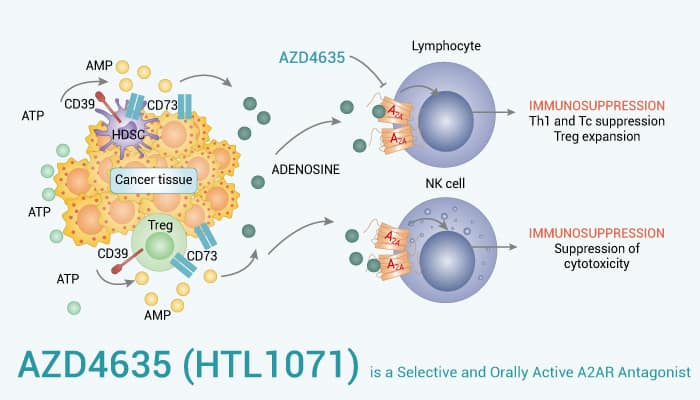Adenosine receptors (ARs) comprise a group of G protein-coupled receptors (GPCR) which mediate the physiological actions of adenosine. To date, four AR subtypes (A1R, A2AR, A2BR, A3R) have been cloned and identified in different tissues. Adenosine receptors play an important role in sleep, the development of cancers and hearing loss. The adenosine A2A receptor (A2AR), also known as ADORA2A, is abundant in basal ganglia, vasculature, T lymphocytes, and platelets. The A2AR also exists in the brain, where it has important roles in the regulation of glutamate and dopamine release. Therefore, it becomes a promising target for the research of conditions such as insomnia, pain, depression, and Parkinson’s disease.
A2AR can suppress immune cells, thereby protecting tissue from inflammation. According to reports, genetic deletion of A2AR and synthetic A2AR antagonists can counteract adenosine immunosuppression and restore antitumor immunity. In addition, adenosine signaling through A2AR promotes tumor growth by facilitating angiogenesis through VEGF production. Adenosine antagonists may, therefore, not only restore antitumor immune responses, but also inhibit tumor growth by impeding adenosine-mediated neovascularization.
AZD4635 is a potent, selective and orally active A2AR antagonist. AZD4635 treatment leads to a broad spectrum of immune modulation, including increase in T cells, importantly tumor antigen-specific CD8+and CD4+ T cells, as well as T cell activation and proliferation. Furthermore, AZD4635 reverses adenosine-mediated immune suppression in T cells, it also reactivates CD103+ DCs. AZD4635 exhibits antitumor activity as a monotherapy and enhances activity of αPD-L1 across a range of syngeneic mouse carcinoma models. All in all, potent inhibition of A2AR with AZD4635 reduces tumor burden and enhances antitumor immunity.

In conclusion, AZD4635 is a potent, selective and orally active A2AR antagonist which reverses adenosine-mediated immune suppression. AZD4635 exhibits anti-tumor activity.
References:
[1]. Willingham SB, et, al. Cancer Immunol Res. 2018 Oct;6(10):1136-1149.